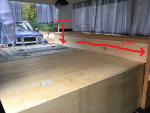Sneaks
Active member
I posted this in my build thread a few days ago, then realized that probably not everyone looks at build threads regularly (or at all), and even less would be interested in an old VW bus thread. Thinking this might be a more logical place to ask this, if it isn't, please guide me to where I should. Thanks!
This pertains to my '79 VW Bus that I'm building out, stock motor, stock 70A alternator, batteries located in factory positions on either side of the engine bay.
I have questions... my crimping supplies showed up today. I have a 150A surge\80A constant isolator kit with 4GA primary wires between the isolator and the batteries. I got a heavy lug crimper tool that can do up to 0GA so I've got that covered, but then I realized I'm not sure how I should cut the cables? Definitely not gonna get done with a pair of dikes or linesman pliers . We carry bolt cutters on our ambulances, I could borrow one to cut it but those really are more "mash it until it succumbs" vs "cutting," awesome in a get-it-done-NOW situation but not the most elegant. Would a grinder with a cutoff wheel be just as good or should I go with the big cutters or is there something else I should consider using?
. We carry bolt cutters on our ambulances, I could borrow one to cut it but those really are more "mash it until it succumbs" vs "cutting," awesome in a get-it-done-NOW situation but not the most elegant. Would a grinder with a cutoff wheel be just as good or should I go with the big cutters or is there something else I should consider using?
The kit says to tap into the ignition but I'm thinking the alt light wire would be a better option as it would only connect them when the alternator is putting out juice instead of combining them as soon as I turn the key? This is how the Westfalia-installed relays were wired up. Yes? No? I can jump from battery to battery if I need to in a no-start, dead main battery situation so having them combined for that purpose isn't a big need. On that, I assume since the two batteries will both be grounded to the chassis, that if I need to do that for a no-start situation, I would only need to jump positive-->positive and not both poles?
The kit has 20' of the 4GA, I'm only going to need about 5' to combine the batteries. I have a fuse panel I'm going to install under the sleep platform. I was going to use 10GA (have 100' of red and black) from the house battery to the panel, but would it make sense to use the 4GA since I have it, even if I don't anticipate much draw? I plan on connecting LED interior lighting, the 100w lights up front, a Coleman cooler, small water pump, and a few 12v outlets for small electronics to the house battery through the fuse panel. I do have a 1500w inverter that will be wired separately direct to the house battery, I've calculated that 10GA would be ok if I keep the run under 4', which I plan on mounting about 18" from the battery, so within the "safe" rating for the max 60A draw. Should I use the 4GA for that too to be safe? Thanks to anyone who replies!
This pertains to my '79 VW Bus that I'm building out, stock motor, stock 70A alternator, batteries located in factory positions on either side of the engine bay.
I have questions... my crimping supplies showed up today. I have a 150A surge\80A constant isolator kit with 4GA primary wires between the isolator and the batteries. I got a heavy lug crimper tool that can do up to 0GA so I've got that covered, but then I realized I'm not sure how I should cut the cables? Definitely not gonna get done with a pair of dikes or linesman pliers
The kit says to tap into the ignition but I'm thinking the alt light wire would be a better option as it would only connect them when the alternator is putting out juice instead of combining them as soon as I turn the key? This is how the Westfalia-installed relays were wired up. Yes? No? I can jump from battery to battery if I need to in a no-start, dead main battery situation so having them combined for that purpose isn't a big need. On that, I assume since the two batteries will both be grounded to the chassis, that if I need to do that for a no-start situation, I would only need to jump positive-->positive and not both poles?
The kit has 20' of the 4GA, I'm only going to need about 5' to combine the batteries. I have a fuse panel I'm going to install under the sleep platform. I was going to use 10GA (have 100' of red and black) from the house battery to the panel, but would it make sense to use the 4GA since I have it, even if I don't anticipate much draw? I plan on connecting LED interior lighting, the 100w lights up front, a Coleman cooler, small water pump, and a few 12v outlets for small electronics to the house battery through the fuse panel. I do have a 1500w inverter that will be wired separately direct to the house battery, I've calculated that 10GA would be ok if I keep the run under 4', which I plan on mounting about 18" from the battery, so within the "safe" rating for the max 60A draw. Should I use the 4GA for that too to be safe? Thanks to anyone who replies!


